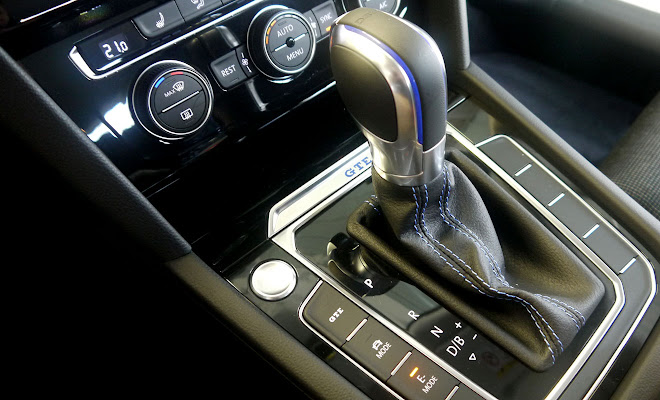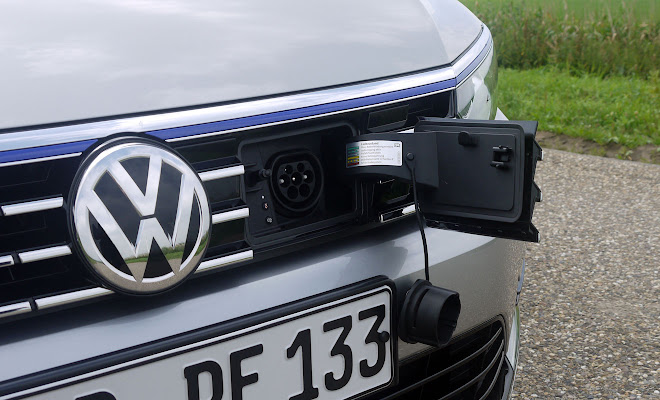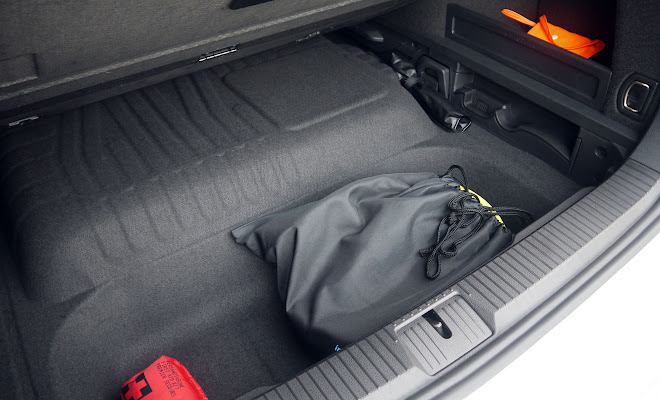by Lem Bingley 
So forgive me for not bothering to record what kind of consumption I saw while testing the new Passat GTE in and around Amsterdam. The numbers would be as relevant to the UK as a field full of tulips and some nice wooden footwear.
As the initials suggest, the new plug-in Passat is closely related to the Golf GTE. Both share essentially the same box of tricks – a 1.4-litre four-cylinder turbo petrol engine, six-speed twin-clutch gearbox, electric motor and lithium-ion battery. The elements aren’t quite identical, however. The engine has been stretched by 15 horsepower, the battery holds 9.9 rather than 8.8 kilowatt-hours of electricity, and the three-phase permanent-magnet motor slipped between engine and gearbox now peaks at 85kW, up from 75kW.

As a result, the substantially larger and 150kg heavier Passat GTE is almost exactly as swift as a Golf GTE. Stamp down in either car and you should get to 62mph before you finish counting to eight. Not bad for a 1.7-tonne estate.
But while you might find yourself rocketing around in the Golf, I’m not sure the Passat lends itself to such shenanigans. Probably because it’s a bigger car, the Passat feels a lot more grown up. Or maybe it’s just the calming effect of Dutch roads and windmills.
On the move, the overriding sensation is serenity. The plug-in Passat is ghostly quiet and effortlessly quick, with finger-light controls and supportive seats. You can drive for half a day and emerge entirely free of any spinal kinks.

You may furrow your brow at the array of driving modes, however. There are five in all, confusingly accessed via three buttons marked GTE, Mode and e-Mode.
Prod the GTE button and the car will throw everything and more at the problem of going faster. I say “more” because the fake-sounding vrooming noises that emerge from the speakers in GTE mode probably aren’t helping unless you’re five years old. Combined, the engine and motor can summon up 160kW of power (about 215bhp) and a beefy 400Nm peak in terms of torque.

Stab the GTE button off and you’ll go into Battery Hold mode, where the car acts like a Prius and will shuffle modest amounts of electricity to and fro as you speed up or slow down, providing still frisky performance without depleting the car’s overall electrical reserves.
The Mode button will let you select a more aggressive Hybrid setting that will gradually eat up battery reserves in aid of fuel efficiency, or there’s a Battery Charge mode that pretty much does the opposite, running the engine to stuff electricity back into the battery, to enable engine-free running at some later point. These options can also be chosen via the central touchscreen.

And finally there’s e-Mode, which uses the electric motor alone to glide along in silence for as long as the battery lasts, at speeds of up to about 80mph and for as much as 30 miles. Though not for 30 miles at 80mph. Helpfully, you can summon up a map overlaid with a blob illustrating how far you might travel before the engine will be forced to fire up.
As long as there’s charge in the battery, the Passat GTE will always wake up in e-Mode.
As with other VW twin-clutch automatics, you have the option to knock the gearstick sideways and shift gears yourself, plus paddles behind the wheel to do the same. There’s also the ability to toggle the stick into a braking mode that employs a stiffer level of energy regeneration – helpful when descending the steep hills that are entirely absent around Amsterdam.

Charging the battery from the mains is done through a socket hidden behind a plastic flap in the car’s front grille. It’s not nearly as enchanting as the socket behind the VW roundel in the nose of a Golf GTE, for reasons I can’t readily explain. Perhaps because VW hasn’t really done a brilliant job of disguising the flap on the Passat, despite creating matching breaks in the chrome slats on the other side of the nose.
Plugged into a household three-pin socket, the charger will draw 10 amps and take about 4 hours and 15 minutes to complete a full charge. A dedicated wallbox will turn the wick up to 16 amps or so and get the job done in two and a half hours.
The GTE estate I drove in Holland featured a fully digital instrument panel, bordering on the bewildering in terms of information but very bright and crisp, and blessed with a helpful scrolling map between its two simulated clocks. The analogue alternative panel is a lot easier to read but provides only basic junction information when guiding you along a route. It’s also Hobson’s choice for UK buyers to begin with, as the digital instruments won’t be ready for right-hand-drive models until mid-way through 2016.

UK prices also remain to be finalised, but expect to pay at least £33,000 after the plug-in grant for the Passat GTE saloon, and about £2,000 more for the capacious estate. Trim will be at the plush GT level, marked out by C-shaped LED daylight lamps and blue details, and there’ll also be an extra-cost model with surround-view monitors and soft leather upholstery.
There is a slight loss of practicality as a result of the GTE’s plug-in power. The battery lives under the rear bench, pushing the fuel tank rearwards to sit like a saddle over the back axle. As a result you can’t carry a spare wheel, and the space under the boot’s usual lift-out floor is home to carpeted lumps and bumps.

That’s a very minor point to carp about. The GTE retains the new Passat’s impressively expansive interior. With a longer wheelbase than the previous generation, there’s plenty of room for ordinary adult limbs in the back yet still ample space for luggage.
Interior appointments are up to high VW standards, lifted by touches of blue stitching for the GTE and even blue mood lighting if you tick the right option boxes. A frameless rearview mirror, shamelessly copied from Volvo, is nonetheless a classy touch.
Overall, it’s hard to think of a more impressive plug-in car for the same kind of money. Volvo’s V60 plug-in costs about £5,000 more, for example, thought it is diesel- rather than petrol-electric, noticeably more powerful and thus a fair bit quicker. The Mitsubishi Outlander PHEV is also a rival, costing about the same as the Passat GTE at the top of its range. But even in its most upmarket leather-decked trim, the Outlander can’t pretend to be cut from the same kind of carefully woven cloth as the Passat.


VW Passat GTE
Rating: stars
Good: spacious, quick and highly refined
Bad: heavy, complex and pricey
Price: from about £33,000 after the Plug-in Car Grant, exact prices to be confirmed
I find myself in Holland again, evidently the launch venue of choice for plug-ins, hybrids and eco-miser cars. I’ve been here before with the Toyota Yaris, Opel Ampera and BlueMotion Golf. It’s a world of arrow-straight roads, modest speed limits, a distinct lack of hills and tarmac as smooth as an iPad’s bottom. If you can’t rack up an impressive economy score here you must have left the fuel cap off. Rating: stars
Good: spacious, quick and highly refined
Bad: heavy, complex and pricey
Price: from about £33,000 after the Plug-in Car Grant, exact prices to be confirmed
So forgive me for not bothering to record what kind of consumption I saw while testing the new Passat GTE in and around Amsterdam. The numbers would be as relevant to the UK as a field full of tulips and some nice wooden footwear.
As the initials suggest, the new plug-in Passat is closely related to the Golf GTE. Both share essentially the same box of tricks – a 1.4-litre four-cylinder turbo petrol engine, six-speed twin-clutch gearbox, electric motor and lithium-ion battery. The elements aren’t quite identical, however. The engine has been stretched by 15 horsepower, the battery holds 9.9 rather than 8.8 kilowatt-hours of electricity, and the three-phase permanent-magnet motor slipped between engine and gearbox now peaks at 85kW, up from 75kW.

As a result, the substantially larger and 150kg heavier Passat GTE is almost exactly as swift as a Golf GTE. Stamp down in either car and you should get to 62mph before you finish counting to eight. Not bad for a 1.7-tonne estate.
But while you might find yourself rocketing around in the Golf, I’m not sure the Passat lends itself to such shenanigans. Probably because it’s a bigger car, the Passat feels a lot more grown up. Or maybe it’s just the calming effect of Dutch roads and windmills.
On the move, the overriding sensation is serenity. The plug-in Passat is ghostly quiet and effortlessly quick, with finger-light controls and supportive seats. You can drive for half a day and emerge entirely free of any spinal kinks.

You may furrow your brow at the array of driving modes, however. There are five in all, confusingly accessed via three buttons marked GTE, Mode and e-Mode.
Prod the GTE button and the car will throw everything and more at the problem of going faster. I say “more” because the fake-sounding vrooming noises that emerge from the speakers in GTE mode probably aren’t helping unless you’re five years old. Combined, the engine and motor can summon up 160kW of power (about 215bhp) and a beefy 400Nm peak in terms of torque.

Stab the GTE button off and you’ll go into Battery Hold mode, where the car acts like a Prius and will shuffle modest amounts of electricity to and fro as you speed up or slow down, providing still frisky performance without depleting the car’s overall electrical reserves.
The Mode button will let you select a more aggressive Hybrid setting that will gradually eat up battery reserves in aid of fuel efficiency, or there’s a Battery Charge mode that pretty much does the opposite, running the engine to stuff electricity back into the battery, to enable engine-free running at some later point. These options can also be chosen via the central touchscreen.

And finally there’s e-Mode, which uses the electric motor alone to glide along in silence for as long as the battery lasts, at speeds of up to about 80mph and for as much as 30 miles. Though not for 30 miles at 80mph. Helpfully, you can summon up a map overlaid with a blob illustrating how far you might travel before the engine will be forced to fire up.
As long as there’s charge in the battery, the Passat GTE will always wake up in e-Mode.
As with other VW twin-clutch automatics, you have the option to knock the gearstick sideways and shift gears yourself, plus paddles behind the wheel to do the same. There’s also the ability to toggle the stick into a braking mode that employs a stiffer level of energy regeneration – helpful when descending the steep hills that are entirely absent around Amsterdam.

Charging the battery from the mains is done through a socket hidden behind a plastic flap in the car’s front grille. It’s not nearly as enchanting as the socket behind the VW roundel in the nose of a Golf GTE, for reasons I can’t readily explain. Perhaps because VW hasn’t really done a brilliant job of disguising the flap on the Passat, despite creating matching breaks in the chrome slats on the other side of the nose.
Plugged into a household three-pin socket, the charger will draw 10 amps and take about 4 hours and 15 minutes to complete a full charge. A dedicated wallbox will turn the wick up to 16 amps or so and get the job done in two and a half hours.
The GTE estate I drove in Holland featured a fully digital instrument panel, bordering on the bewildering in terms of information but very bright and crisp, and blessed with a helpful scrolling map between its two simulated clocks. The analogue alternative panel is a lot easier to read but provides only basic junction information when guiding you along a route. It’s also Hobson’s choice for UK buyers to begin with, as the digital instruments won’t be ready for right-hand-drive models until mid-way through 2016.

UK prices also remain to be finalised, but expect to pay at least £33,000 after the plug-in grant for the Passat GTE saloon, and about £2,000 more for the capacious estate. Trim will be at the plush GT level, marked out by C-shaped LED daylight lamps and blue details, and there’ll also be an extra-cost model with surround-view monitors and soft leather upholstery.
There is a slight loss of practicality as a result of the GTE’s plug-in power. The battery lives under the rear bench, pushing the fuel tank rearwards to sit like a saddle over the back axle. As a result you can’t carry a spare wheel, and the space under the boot’s usual lift-out floor is home to carpeted lumps and bumps.

That’s a very minor point to carp about. The GTE retains the new Passat’s impressively expansive interior. With a longer wheelbase than the previous generation, there’s plenty of room for ordinary adult limbs in the back yet still ample space for luggage.
Interior appointments are up to high VW standards, lifted by touches of blue stitching for the GTE and even blue mood lighting if you tick the right option boxes. A frameless rearview mirror, shamelessly copied from Volvo, is nonetheless a classy touch.
Overall, it’s hard to think of a more impressive plug-in car for the same kind of money. Volvo’s V60 plug-in costs about £5,000 more, for example, thought it is diesel- rather than petrol-electric, noticeably more powerful and thus a fair bit quicker. The Mitsubishi Outlander PHEV is also a rival, costing about the same as the Passat GTE at the top of its range. But even in its most upmarket leather-decked trim, the Outlander can’t pretend to be cut from the same kind of carefully woven cloth as the Passat.




